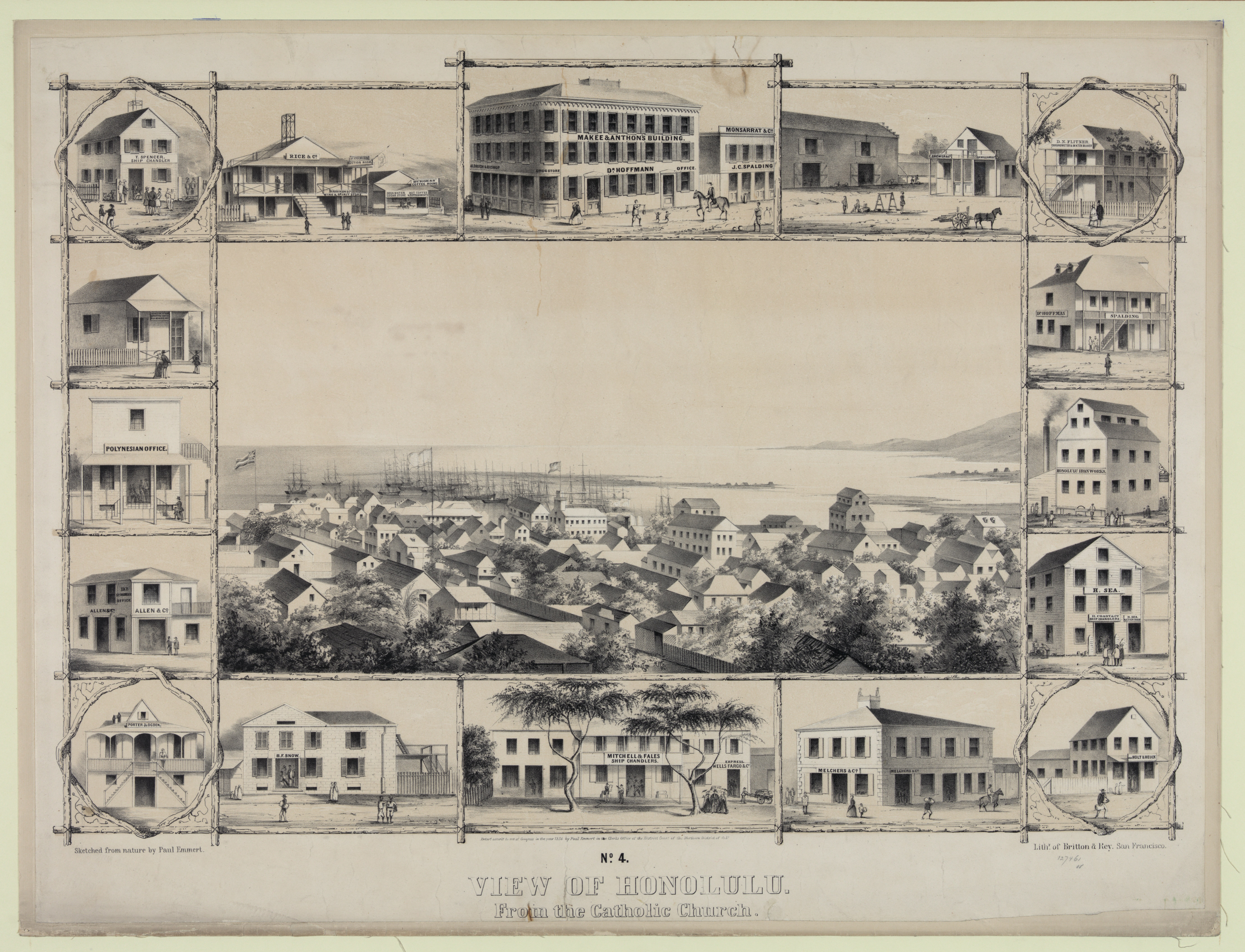Born near Bern, Switzerland, in 1826, Paul Emmert (1826‒1867) immigrated to the United States at the age of 19, landing first in New York and then heading west with the discovery of gold in California.
In 1853, he became one of the many artist-travelers to come to Hawai‘i to satisfy the thriving market for images of the islands’ dramatic topography and singular culture.
In Honolulu, he opened a print shop, where he made prints after his own drawings of local landmarks. Eventually, he moved to Kailua-Kona and farmed the sugar plantation where he lived out the remainder of his life.
In his 14 years in Hawai‘i, Emmert made drawings of the mountains, coastlines, vegetation, and geophysical phenomena in and around O‘ahu, Maui and the Island of Hawai‘i.
While Emmert was in Honolulu he made a series of sketches of Honolulu, one from the harbor and five from the bell-deck of the Catholic Cathedral.
The Cathedral of Our Lady of Peace, located at the north end of Fort Street (and Beretania) in downtown Honolulu, is said to be the oldest Catholic cathedral in continuous use in the United States and one of the oldest existing buildings in the downtown area.
The Cathedral stands on land which was given to the Catholic missionaries by King Kamehameha III (Kauikeaouli) when the mission was established in 1827.
Here is a summary of the images in the six sketches of Honolulu:
No. 1. View of Honolulu from the Harbor (1854)

Center image is view looking mauka at Honolulu Harbor from the water.
Smaller images, circling the center image, include various buildings: (clockwise from top left) the Royal School, Custom House, interior of the Fort, market house, charity school, stone church, “Bethel” (Bethel Church?), armory, court house, palace of King Kamehameha III, Honolulu House, the steamer Akamai, the native church and the Catholic church.
No. 2. View of Honolulu from the Catholic Church (1854)

Central image is view looking toward Diamond Head.
Smaller images, circling the center image, include various residences and consulates: (clockwise from top left) John Yung; Mr. Angel, U.S. Consul; General Miller, H.B.M. Consul General; Mr. Perrin, French Consul; Prince Alexander and Lot; Mr. Armstrong; L. Anthon, Danish Consul; U.S. Consulate; King’s summer house; Mr. Hackfield, Swedish Consul; Mr. Montgomery; Mr. Gregg, U.S. Commissioner; Mr. Wyllie; Mr. Davis, Peruvian Consul; Mr. Hall; Mr. Reynolds, Bremen Consul.
No. 3. View of Honolulu from the Catholic Church (1854)

Center image is view looking toward Kakaʻako.
Smaller images, circling the center image, include various businesses and buildings: (clockwise from top left) Dentist, MacFarlane Hotel, National Hotel & Billiard Saloon, French Hotel, F. Spencer, Lafrenz & Fisher Cabinet Makers, Tailoring by Chas. Nicholson, Stuart & Rahe Cabinetmakers and Turners, Dr. Lathrop Drug Store, Hudsons Bay Company, Globe Hotel, Chas. Vincent, Reynolds, French Store, Ruggles and H Hackfeld & Co.
No. 4. View of Honolulu from the Catholic Church (1854)

Center image is view looking makai toward Honolulu Harbor.
Smaller images, circling the center image, include various businesses and buildings: (clockwise from top left) T. Spencer Ship Chandler, Rice & Co., Makee & Anthon’s Building, C. Brewer, DN Flitner Watch Maker, Dr Hoffman – Spalding, Honolulu Iron Works, H Sea – R Coady, Holt & Heuck, Melchers & Co., Mitchell & Fales – Wells Fargo & Co., BF Snow, Porter & Ogden, Allen & Co., Polynesian Office and Hawaiian Steam Navigation Office.
No. 5. View of Honolulu from the Catholic Church (1854)

Center image is view looking toward Central Oʻahu.
Smaller images, circling the center image, include various residences: (clockwise from top left) Boullion, Dubois, Capt. Snow, Cartwright, Spencer, Spalding, Ford, Capt. Crab, Sea, Newcomb, Bungalow, Dr. Wood, Sommner, Macfarlane, Porter & Ogden and Dowsett.
No. 6. View of Honolulu from the Catholic Church (1854)

Center image is view looking mauka toward Nuʻuanu Valley.
Smaller images, circling the center image, include various residences: (clockwise from top left) Dr, Lathrop, Paki, Washington Place, John Ji, Judge Andrews, Bishop, Capt. Luce, Rev. Damon, Dr. Hildebrand, Dr. Judd, Capt. Makee, Bates, Nuʻuanu Valley Waterfall, Wood, Wood and Ladd.
© 2022 Ho‘okuleana LLC


























